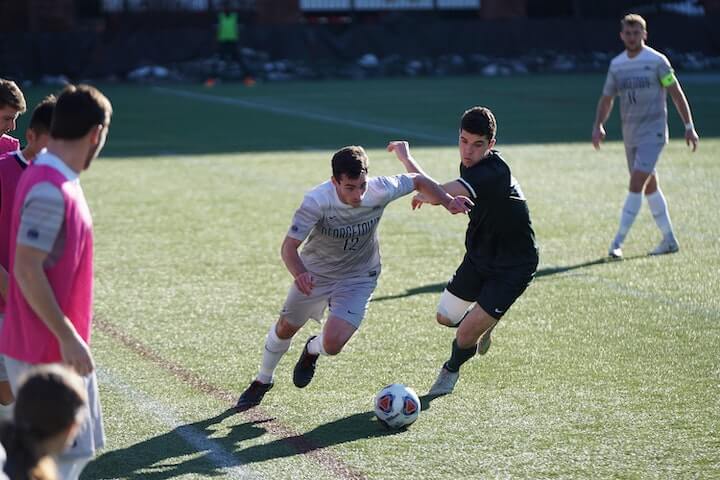Soccer Cuts and Turns (Inside, Outside, and More)
Every soccer player needs fundamental dribbling skills to weave their way out of tricky situations.
Before expanding your skill set with complex step-overs and advanced footwork, you must master basic soccer cuts and turns.
While rudimentary, these are important to change direction when you’re on the ball.
Adding such skills lays the perfect foundations to become a better dribbler. Then you can build your repertoire and develop as a more dynamic threat with the ball at your feet.
Below, I explain what soccer cuts and turns are and show how you can use them in-game.
What are Soccer Cuts?
"Soccer cuts" are moves where you make a rapid change of direction while dribbling.
Although players can execute cuts at any speed, they’re most effective when traveling at pace as you can use your momentum to cut a new path into space and accelerate past a defender.
The main aim of a cut is to evade a tackle or defender when you’re dribbling forward.
However, you can also use a cut to flick the ball through a tight space and dribble to safety.
There are two main types of soccer cuts:
- Inside Cut
- Outside Cut
#1 - Inside Cut
An inside cut involves using the inside of your foot to move the ball across your body and into space.
It’s a useful move for wingers or fullbacks to cut inside and redirect their run toward the goal.
While basic, this move can be extremely effective when moving at speed.
Here are the steps you need to pull it off:
1. Dribble in a straight line toward a defender or target.
2. Plant your pivot foot (the foot to the side you’re changing direction to).
3. With your other foot, use your instep or toe to shift the ball across your body and into the space.
4. Push off your standing foot and accelerate away from the cutting spot.
5. Regain possession of the ball and continue dribbling.
You can perform an inside cut at a variety of angles.
For example, you may want to cut inside slightly at a narrow-angle to get past a defender. Or, you might need to do a total 180 to escape a defender who’s forcing you into the corner.
The greater the cutting angle, the more you need to adjust your pivot foot toward the direction you want to go in.
#2 - Outside Cut
An outside cut involves using the outside of your foot to change the direction of the ball.
It’s a common move performed by players in all positions to flick the ball away from an oncoming opponent.
Oftentimes, players lift the ball into the air slightly in case the defender sticks out a leg to block the kick.
An outside cut is generally easier to pull off than an inside cut because it’s a more natural movement and involves less torsion of the body.
Here are the key steps:
1. Dribble toward a defender or target;
2. Just before you get there, plant your pivot foot away from the direction you want to go in;
3. Load your hip on your pivot foot;
4. With your kicking foot, point your toes downward then flick the ball away from your body using the outside of your foot;
5. Explode away from the defender, utilizing your loaded hips to generate rapid acceleration;
6. Regain possession of the ball and continue dribbling.
Again, you can perform an outside cut at a wide variety of angles.
Soccer Cutting Tips
As an isolated skill, soccer cuts are straightforward and easy to perform.
That said, it requires timing, a deft touch, and correct body posture to pull off consistently.
A few things:
a. Don't telegraph where you’re about to go.
Instead, you must draw the defender in, then cut away with the ball into space just before they commit to a tackle.
b. Be aware of your surroundings to avoid running into the secondary defender.
c. The weight of your touch is paramount.
Kick the ball too hard and you’ll lose control.
Take too soft a touch and you run the risk of losing possession.
The firmness of the touch must be just right to evade the defender while maintaining control over the ball. Drilling and repetition are key to mastering this skill.

What is a Soccer Turn?
Soccer players "turn" in many different ways. Either to beat an opponent 1v1, take a touch into space, evade an oncoming defender, or get out of a tight space.
Essentially, a cut is a type of turn. However, it’s a specific move used to change direction with the ball and get past an opponent.
Regardless of your position on the field, it’s important to have a few turns up your sleeve to escape an opponent’s clutches.
Types of Soccer Turns
The key to a good turn is to sell a defender in one direction and then go in the other.
As I mentioned, there are countless ways to turn.
Depending on the circumstances, certain movements are more effective.
For example, if you want to turn towards goal with a defender on your back, a one-touch flick around them gives you space to spin away and create space.
If you’re in a congested area, however, you may need a more elaborate trick.
Here are three basic to intermediate turns worth adding to your toolkit.
#1 - One-Touch Spin
The one-touch spin is an essential turn for a striker or midfielder who frequently receives the ball with their back to goal.
Rather than controlling the ball and then trying to beat a defender 1v1, the one-touch spin involves:
1. Flicking the ball into space with your first touch.
2. Spinning the defender and regaining possession.
Firstly, you must make sure to pin the defender back, shielding them from the pass.
When the ball comes your way, act as though you’re going to hold the ball up.
But then with your first touch, flick the ball around the defender using the outside of your foot (preferably your strong foot).
Use the momentum of the kick to spin in the opposite direction around the defender then rush onto the ball.
The two most important aspects of this move are:
1. Feinting that you’re holding up the ball.
2. Taking a controlled touch in the direction you want to go.
Practice this drill without pressure to get a feel for the technique, then start attempting it with real players.
#2 - Ronaldo Chop
The “Ronaldo Chop” is somewhat of a hybrid of a turn and a cut.
It gained its name during Cristiano Ronaldo’s peak, as he used this soccer move to great effect throughout his career.
Rather than using the inside or outside of your foot to cut the ball, flick it with your heel and pass the ball across the back of your standing leg, similarly to a back heel.
Because you cut the ball behind your leg, you essentially protect it from the defender.
However, the heel flick poses difficulties as it’s more difficult to control.
Many players hop into the move as this creates more space to pass the ball across your leg and it gives you a springboard to accelerate in another direction.
When mastered, the Ronaldo Chop is a fantastic turn and it can be easily paired with a fake shot or cross for even more effectiveness.
#3 - Cruyff Turn
The Cruyff turn, made famous by Johan Cruyff, is the most recognized turn in all of soccer.
It’s not just a well-known move, however... it’s also extremely effective.
Players in all positions use this turn every game to send a defender in the wrong direction.
Here’s how to do it:
1. With a defender closing you down, set the ball out slightly in front of you
2. Pull your leg backward as if you’re about to make a pass or take a shot
3. At the moment of contact, hook your foot around to the front of the ball
4. Rather than striking the ball as normal, drag it back through your legs
5. Swivel your body quickly to change direction
6. Accelerate away or make a pass.
The key to a successful Cruyff turn is to sell the fake. If the defender senses that you have no realistic passing options, they’re likely to read what you’re about to do.
Conclusion
Solid foundations can get you a long way in the beautiful game.
Even basic soccer cuts and turns are highly effective when used in the right ways.
Before you start working on highlight reel tricks, be sure to master the fundamentals.
The moves outlined in this article are the ones you can fall back on in big moments.

